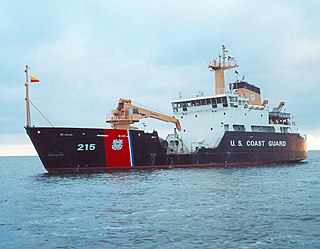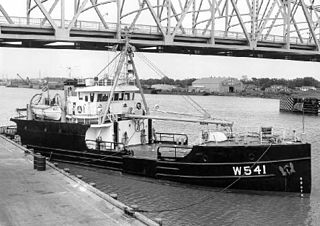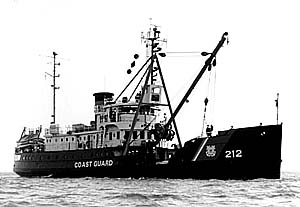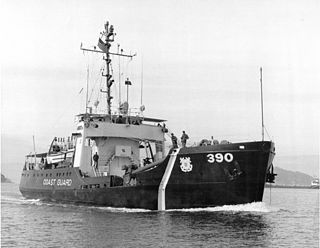External links
- "Inland Buoy Tenders, (large-small) (WLI)". Aircraft, Boats, and Cutters: Cutters. United States Coast Guard.
There are two classes of USCG Inland Buoy Tenders.
The 100-foot Class Inland Buoy Tenders consists of the following boats:
The 65-foot Class Inland Buoy Tenders consists of the following boats:

USCGC Sequoia (WLB-215) is a United States Coast Guard 225-foot Seagoing Buoy Tender, homeported in Apra Harbor, Naval Base, a deep-water port on the western side of the United States territory of Guam.

The USCG seagoing buoy tender is a type of United States Coast Guard Cutter used to service aids to navigation throughout the waters of the United States and wherever American shipping interests require. The U.S. Coast Guard has maintained a fleet of seagoing buoy tenders dating back to its origins in the U.S. Light House Service (USLHS). These ships originally were designated with the hull classification symbol WAGL, but in 1965 the designation was changed to WLB, which is still used today.

The United States Coast Guard commissioned a new Keeper class of coastal buoy tenders in the 1990s that are 175 feet in length and named after lighthouse keepers.

USCGC Maple (WLB-207) is a Juniper-class seagoing buoy tender operated by the United States Coast Guard. She was based at Sitka, Alaska for 16 years and is currently homeported at Atlantic Beach, North Carolina. Her primary mission is maintaining aids to navigation, but she also supports search and rescue, law enforcement, oil spill response, and other Coast Guard missions.

United States Coast Guard Cutter is the term used by the U.S. Coast Guard for its commissioned vessels. They are 65 feet (19.8 m) or greater in length and have a permanently assigned crew with accommodations aboard. They carry the ship prefix USCGC.

A buoy tender is a type of vessel used to maintain and replace navigational buoys. This term can also apply to an actual person who does this work.

The USCGC White Alder (WLM/WAGL-541) was the former Navy lighter, YF-417. The United States Coast Guard acquired a total of eight of these former Navy YF-257-class lighters between 1947-1948 for conversion to coastal buoy tenders. They were needed to complement the larger seagoing buoy tenders in servicing short-range-aids-to-navigation, typically those placed in coastal waters and harbors.

The United States Coast Guard Cutter Fir was the last lighthouse tender built specifically for the United States Lighthouse Service to resupply lighthouses and lightships, and to service buoys. Fir was built by the Moore Drydock Company in Oakland, California in 1939. On 22 March 1939, the U.S. Lighthouse Tender Fir was launched. She was steam driven with twin screws, 175 feet (53 m) in length, had a beam of 32 feet (9.8 m), drew 11 feet 3 inches (3.43 m) of water, and displaced 885 tons. Fir was fitted with a reinforced bow and stern, and an ice-belt at her water-line for icebreaking. She was built with classic lines and her spaces were lavishly appointed with mahogany, teak, and brass. The crew did intricate ropework throughout the ship. The cost to build Fir was approximately US$390,000. Fir's homeport was Seattle, Washington for all but one of her fifty one years of service when she was temporarily assigned to Long Beach, California when USCGC Walnut was decommissioned on 1 July 1982.

USCGC Fir (WLB-213) is a Juniper-class cutter of the United States Coast Guard. USCGC Fir is under the Operational Control (OPCON) of the Commander of the Thirteenth Coast Guard District and is homeported in Astoria, Oregon. Fir's primary area of responsibility is the coastal waters, river bars and high seas of the Washingtonian and Oregonian coasts. USCGC Fir conducts heavy lift aids to navigation operations, law enforcement and other missions as directed.

USCGC Elm (WLB-204) is a U.S. Coast Guard Juniper-class seagoing buoy tender home-ported in Astoria, Oregon. She is responsible for maintaining aids to navigation on the coasts of Oregon and Washington, including the Columbia River.

United States Coast Guard Station Woods Hole is a United States Coast Guard station located in Woods Hole, Massachusetts. The station is home to Sector Southeast New England.

USCGC Smilax (WAGL/WLIC-315) is a 100-foot (30 m) United States Coast Guard Cosmos-class inland construction tender, commissioned in 1944. Smilax is the "Queen of the Fleet", as the oldest commissioned U.S. Coast Guard cutter.
An inland construction tender is a type of ship used to build and service shore structures such as piers and buoy trestles. It is also used to maintain buoys and aids to navigation. Less frequently, they may be used for law enforcement, environmental, icebreaking, and search and rescue operations.
USCGC Kukui (WLB-203) is the third cutter in the Juniper-class 225 ft (69 m) of seagoing buoy tenders and is the third ship to bear the name. She is under the operational control of the Commander of the Seventeenth Coast Guard District and is home-ported in Sitka, Alaska. Her primary area of responsibility is the inland and coastal waters of southeastern Alaska. Kukui conducts heavy lift aids-to-navigation operations, and law enforcement, homeland security, environmental pollution response, and search and rescue as directed.

The USCGC Blackhaw (WLB-390) was a Iris-class buoy tender belonging to the United States Coast Guard launched on 18 June 1943 and commissioned on 17 February 1944.

USCGC Bluebell (WLI-313) is a United States Coast Guard inland buoy tender based out of Portland, Oregon.

Coast Guard Base Ketchikan is a major shore installation of the United States Coast Guard located in Ketchikan, Alaska. The base is a homeport for two Sentinel-class cutters and a buoy tender, and is the only Coast Guard dry dock in the state. Located one mile south of the city's downtown area along the southwestern shore of Revillagigedo Island, the base was originally established in 1920 to support the United States Lighthouse Service and became part of the Coast Guard in 1940. In addition to the homeported cutters, Base Ketchikan's maintenance facilities support forward-deployed cutters throughout Southeast Alaska, in Petersburg, Juneau and Sitka.

USCGC Elderberry (WLI-65401) is an inland buoy tender of the United States Coast Guard. She is based at Petersburg, Alaska and is responsible for maintaining aids to navigation. Her efforts are focused on waterways that are especially shallow or restricted.